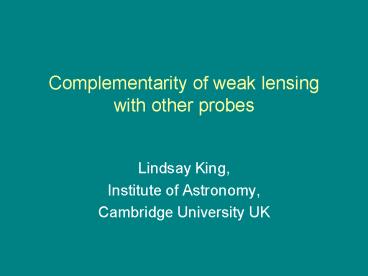Complementarity of weak lensing with other probes PowerPoint PPT Presentation
1 / 18
Title: Complementarity of weak lensing with other probes
1
Complementarity of weak lensing with other probes
- Lindsay King,
- Institute of Astronomy,
- Cambridge University UK
2
From Tegmark
3
Cosmic shear constraints can be almost orthogonal
to CMB
future space cosmic shear
WMAP-1 CBI
shear survey specs
Tereno et al. 2004
Provides lever for parameter constraint on small
scales
4
Parameter estimation from Planck data
Planck operational end 2008 Ignoring CMB
lensing biases parameter estimates
Lewis 2005
5
Neutrino mass Ly-alpha forest, CMB lensing,
Planck constraints
Neutrino masses affect cosmic history structure
formation. A main effect is suppression of power
on small scales, roughly proportional to neutrino
contribution to matter content.
Gratton, Lewis Efstathiou 07
Lesgourgues et al. 06
6
Testing the CDM paradigm on galaxy cluster scales
- Cluster mass function and density profiles are a
sensitive - test of cosmology.
- Weak lensing probes scales dominated by dark
matter - but relies on having sufficient background
galaxies. - A number of massive high redshift (z1.4) x-ray
clusters - have been reported (e.g. Mullis et al. 2005) -
possibly indicative of early dark energy
(Bartelmann et al. 2006) - CMB lensing by clusters as a complementary tool?
7
Futuristic constraints on clusters from lensing
of CMB and weak lensing of galaxies
500 gal/arcmin sq. photo-z estimates
space-based, galaxy lensing
CMB (polarisation) lensing
?2 x 0.1 ?K / 0.5 arcmin pixel on Stokes
parameters
Less futuristic constraints imply CMB lensing
better for clusters beyond z0.8
Lewis King 2006
8
The inner regions of clusters home to strongly
lensed giant arcs
Li et al. (2006) discuss how giant arc statistics
seem to be in conflict with WMAP3 o.depth 6
below ?CDM0 (?80.9 ?m0.3). Even ?CDM0 must
be pushed to be consistent with observations!
- Future surveys will detect thousands of clusters
creating - giant arcs! Better statistics.
- Campaigns to obtain photometric/spectroscopic
redshifts for lensed objects (to which this
analysis is sensitive) will increase the power of
arcs as a cosmological tool.
9
triaxiality
ellipticity in potential
Corless King 07
Meneghetti et al.
not isolated
(lensing)
(spectroscopy)
r
c
M
King Corless 07
Lokas et al 06
10
Probing dark matter and baryons on small scales
- Galaxy-galaxy weak lensing probes ensembles of
galaxies on scales where dark matter dominates. - The relationship between baryons and dark matter,
as a function of mass and environment, is
essential to understanding both galaxy and
cluster formation. - Future surveys will contain 105 strongly lensed
galaxies, and 103 strongly lensed quasars! - Observational requirements covered by weak
lensing requirements.
11
Strong lensing (/- stellar kinematics) gives
galaxy density profiles very close to isothermal
inside ?E
Log density slopes for early-type field
lenses (SLACS/LSD)
Koopmans et al 2006
Average density profile from time delays of 10
lenses
Dobke King 2006
12
- On larger scales profiles also consistent with
isothermal - From galaxy-galaxy lensing (e.g. Wilson et al.
01, - Sheldon et al. 04, Mandelbaum et al. 06)
- Weak lensing around SLACS strong lenses
- (Gavazzi et al. 2007)
- Total density profile close
- to isothermal over wide range
- of scales.
- Outer halos of strong lenses
- similar to typical field galaxies.
Gavazzi et al. 2007
13
- But for galaxies in denser environments evidence
for deviations from isothermal (e.g. Kochanek et
al. 06, Dobke et al. 07, Read et al. 07) - Simulations show slope changes in strong lensing
regions
Dobke, King Fellhauer 2007
- Tidal truncation of DM halos seen in very dense
environments - (e.g. Natarayan et al.02, Limousin et al.07
Halkola et al.07)
14
On cluster scales probed by weak lensing, halos
consistent with NFW.... Isolated galaxies
consistent with isothermal.... What about
intermediate scales?
Weve started to carry out a search for large
separation lenses in SDSS. One of the first
discoveries is a 10 almost compete Einstein
ring lens is a very massive LRG.
Belokurov et al. 2007
Future large surveys will allow us to detect many
lenses, and hence study the interplay between
baryons and dark matter as a function of mass and
environment.
15
Testing models of the early universe
- String loops predicted in different amounts by
different brane inflation models - Long strings collide reconnect
- to form loops
- Of order 105 loops compared with 40 long
strings per horizon volume!
Allen Shellard
16
How can we directly detect loops?
- Strong lenses - Schwarzschild lens well outside
loop. - CLASS/JVAS lens surveys demonstrated advantages
of targeting compact, flat spectrum, radio
sources. - Large number of these radio sources in future
radio surveys increase detection probability of
loop lenses e.g. 108 expected in future
half-sky SKA survey. - Window on the physics of the early universe?
17
Looks very promising...
CLASS
LOFAR
SKA (2020) 108 CRSs
Mack, Wesley King 2007
18
- The future of weak lensing from space holds
great promise. - Along with other tools, tighter constraints on
our cosmological - model will be obtained.
- Massive objects can be probed on a wide range of
scales, - testing the CDM paradigm and helping us better
understand - structure formation.
- Future CMB experiments offer a means to study
the highest - redshift clusters via their lensing signatures.
- Models of brane inflation will be tested by the
presence - - or absence - of string loop strong lensing events
in future - radio surveys such as SKA.

